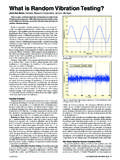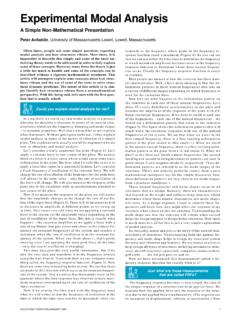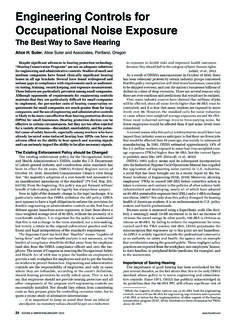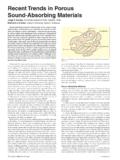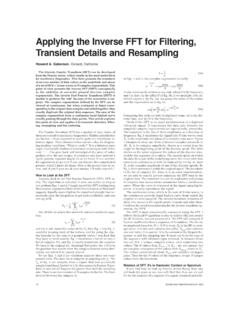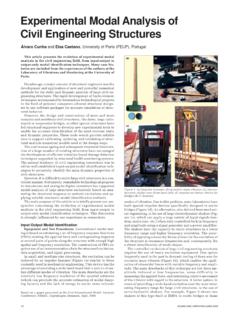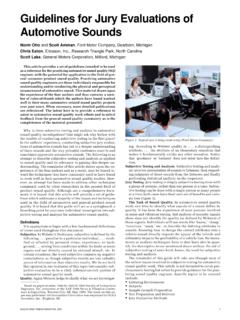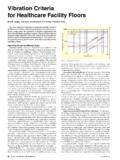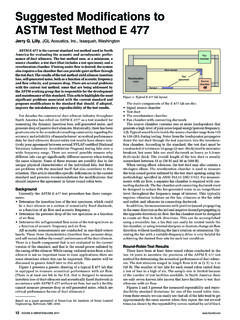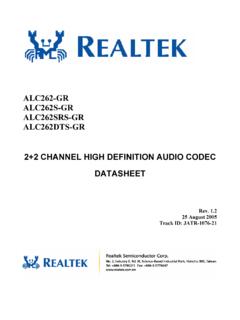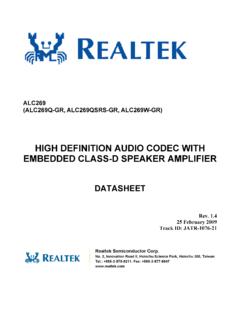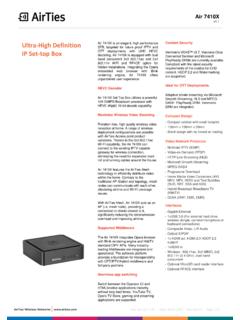Transcription of Effective Design of Audio/Video Conference Rooms
1 SOUND & VIBRATION/JULY 2012 Economic pressures, changing business models, and environ-mental concerns are increasing the use of video conferencing, telepresence, and distance-learning technologies in academic and corporate settings. A successful return on investment for these systems rests on their adoption among prospective users. Acceptance is maximized when the conferencing system provides a realistic virtual presence between users. Acoustics and speech intelligibility are key components of this effect. This article pres-ents an overview of different conferencing technologies, their acoustical requirements, and built-in acoustical controls such as echo-cancellation, noise reduction, and voice ultimate intention of any Conference system is to facilitate communication between remote participants.
2 This communication can include speech, program audio , video, presentation materials, computer files, and images of physical documents. Many systems are also capable of capturing this content for future viewing. Confer-ence systems employ a variety of technologies in vastly different settings and for vastly different purposes. The ultimate goal is to provide users with the desired level of communication while balancing convenience, cost, flexibility, and of Conferencing SystemsPrior to discussing the acoustical requirements for audio and video conferencing facilities, it is necessary to understand the various functions of these Rooms and the technologies that are employed.
3 There is a continuum between each of the systems and technologies presented here. Each is scalable from a small single-user system to multiuser applications, including auditori-ums and courtrooms. In general, the cost and complexity of each system is directly related to its functionality and the number of participants. Likewise, the need for good acoustics increases along these same Conferencing (Teleconferencing). A telephone confer-ence between two endpoints equipped with standard telephone handsets or speakerphones is the simplest form of conferencing. There are also dedicated desktop conferencing systems containing specialized microphones and built-in speakers that can provide an improvement in pickup sensitivity and far-end audio fidelity over standard handsets.
4 If multiline handsets or desktop conferencing systems are used, more than two endpoints can participate in a Conference , though overall sensitivity and fidelity of the Conference may suffer as more parties are overcome this, a remote (off site) audio bridging service may be employed. The teleconference host and invited participants typically call into a toll free number and enter a Conference access number to join the audio Conference . audio quality is assured by the audio bridging service through its use of sophisticated audio conferencing electronics. Teleconferencing by the use of handsets, desktop conferencing systems, and third-party bridging services comprises a system that is simple to use and does not require the users to possess specialized equipment.
5 A standard teleconference experience may be enhanced through the use of web conferencing software, such as Smart Technologies Bridgit and Cisco s Conferencing. When conferencing audio fidelity is critical or when the number of participants at a conferencing site exceeds the performance capabilities of handset or tabletop conferencing systems, an audio conferencing system with a telephone system interface may be deployed. These high-end audio conferencing systems are similar in function to standard teleconferencing systems but utilize specialized audio conferencing equipment capable of handling many microphones and loudspeakers.
6 This type of system can be quite complex and can incorporate a rack-mounted codec (coder-decoder) paired with digital signal proces-sors and specialized microphones. A telephone-hybrid interface provides connectivity between the audio Conference system and the telephone system. These systems are often permanently or semipermanently installed in purpose-built Conference Rooms . Like a standard teleconference system, an audio Conference system can be enhanced through the use of web conferencing software, such as Smart Technologies Bridgit and Cisco s Video Conferencing. Desktop video conferencing is similar to basic telephone conferencing, but it is paired with a simple video feed of a participant s face.
7 audio and video from each participant are captured using a computer equipped with a simple web camera and possibly a headset microphone. audio and video signals are typically transmitted over each user s internet con-nection in conjunction with desktop file-sharing and collaboration software. Other systems may use a video-capable telephone handset to transmit audio and video signals across a corporate local-area network (LAN) or an IP connection. Like telephone conferencing, this method of conferencing requires almost no special equipment. Unlike telephone conferencing, desktop conferencing systems offer more robust communication and almost limitless Conferencing.
8 Similar to high-end audio conferencing, high-end video conferencing takes place in a purpose-built con-ference room using a permanently or semipermanently installed system. These systems will generally use multiple microphones, loudspeakers, cameras, displays, and software to transmit audio and video communication between users. Application sharing allows users to share presentations, graphics, videos, electronic white boards, and document cameras. Some systems even allow virtual content creation and video-conferencing is highly desirable, because it al-lows face-to-face discussion between participants.
9 These face-to-face communications allow participants to communicate using body-language as well as speech. The addition of video improves participant relationships and fosters collaboration. In today s global economy, businesses and educators seek to communicate with users throughout the world. Video-conferencing systems facilitate these communications, while eliminating the costs and carbon footprint associated with the travel required for an actual face-to-face , the largest impediment to video conferencing is uni-versal adoption of technologies that are sometimes proprietary, meaning users at each endpoint must employ a system from a single manufacturer.
10 Communication between different manufacturers systems often has limited functionality and fidelity. Important meetings between different systems currently require a test call and may require adjustment of complex system settings. To this end, most video conferencing involves interorganization commu-nications. Too often other communications are not user friendly. A second major barrier is user habit; however, with the advent of Skype, Google Chat, ubiquitous web-cameras, Apple s FaceTime, and cell phones with video conferencing capabilities, upcoming generations of digital natives will not only be comfortable with these technologies, they will demand Telepresence.
